 First of all, we finally agreed on a name for our Maremma: “Bronte” (spelled without the umlaut- because who wants to spell a dog’s name with an umlaut?). Here is a photo of her with the ram, taken by our neighbor Marla. She and the ram get on pretty well. If she tries to tug at his ears too much and gets on his nerves, he pushes her down and hurts her. So, they have their relationship sorted out! 🙂
First of all, we finally agreed on a name for our Maremma: “Bronte” (spelled without the umlaut- because who wants to spell a dog’s name with an umlaut?). Here is a photo of her with the ram, taken by our neighbor Marla. She and the ram get on pretty well. If she tries to tug at his ears too much and gets on his nerves, he pushes her down and hurts her. So, they have their relationship sorted out! 🙂
You’ll note the long-line she’s wearing. This is a great secret I learned long ago from Patty Ruzzo in a seminar. Patty is now passed on, but she was a well-known dog trainer who was highly successful in Obedience competition, and I learned many valuable things from her and think of her often.
We all know that puppies usually go through a “keep-away” age, where they start to learn they can run faster than we can, and that being caught is not fun. But, traditional store-bought dog long-lines used for controlling keep-away dogs are heavy and cumbersome. If you are training a dog to jump or herd, regular long-lines can get dangerously tangled on things. So this was Patty’s solution: grosgrain ribbon. This is a special kind of ribbed ribbon you can buy at a fabric store- it is quite strong, and inexpensive. Tie 10 yards of it to a brass clip, and you have a fabulous, lightweight long-line that “floats” along as the dog runs. It’s slippery so it rarely tangles with solid objects. And, if a dog really hits it hard, it breaks, saving their neck from serious injury.
This long-line is so lightweight the dog forgets he is wearing it. And, the best part is that you can step on it when you are calling him, and then just stand their casually like you haven’t done anything at all. He has no idea what has just occurred, and he starts to develop a superstitious belief that you are God-like, and can stop him in his tracks when you call him. Much better than stooping to pick up a heavy long-line, so the dog figures out “oh, if I run fast enough to get that long-line out of your reach, I’m home-free!” Instead, with this long-line, the dog starts to believe that when you call, there is no choice but to come.
So, this is what Bronte is wearing most of the time. She is still at a very silly age, and is easily intimidated by us, so when we are out in the pasture, she bounces around and woofs, trying to initiate the keepaway game, half afraid of being snagged. When she does this, I ingore it, and now and then, step on the long-line, catch her, pet and praise her then let her go. The long-line is reasonably safe for her to wear in the pasture- there is not much for it to get stuck on. She has broken (or chewed?) it a couple of times, but I just re-tie it while she’s enjoying eating her dinner, and she is rarely the wiser. Her dinner is my best puppet string: she must eat it while I pet her if she wants to eat.
I used a line like this for many months on my “remedial” Border Collie, Gene. Gene was horrible about keepaway, for much of the first year of her life! Especially in a pasture with sheep. And, when Gene is frightened or upset, she flees, unlike most dogs who seek comfort from their owners when scared. I attribute this brilliant and simple invention to me eventually getting Gene under voice control, and now she has very good call-offs when she is working livestock, and will even reluctantly come to me when she is hurt or panicked.
So, I’m hoping, if it worked for Gene, it’ll work for Bronte! So far it seems to be doing the trick! Training an LGD is very different for me, as I only have a few minutes per day of interaction with her, as compared to a competition and house dog that gets many hours of intensive interaction per day. So, I have to make the most of every minute I’m in the pasture, to teach her the things she needs to know!
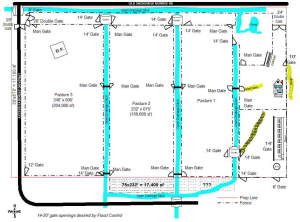



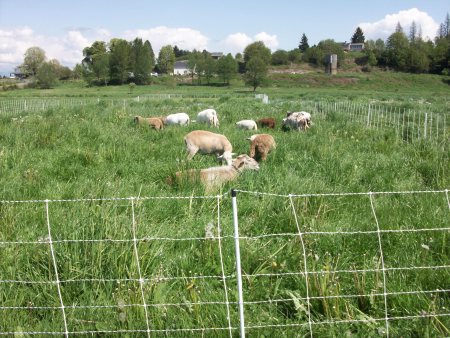
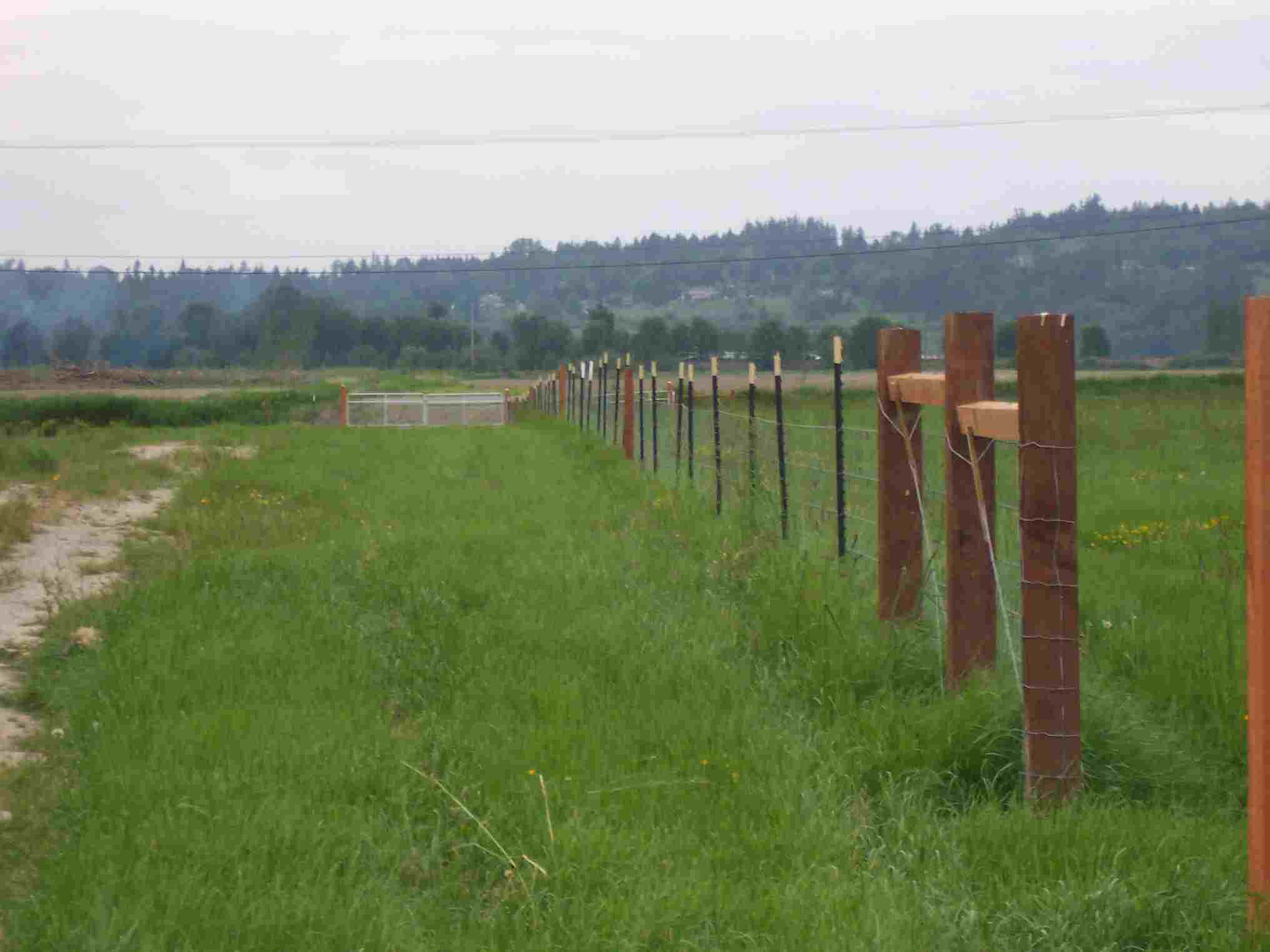 I’m gearing up to start another round of fencing. I do add concrete my fence post holes, because in the floodplain, the flotation forces of full-submersion flooding can cause whole fence lines to float- or so I’m told by a neighbor who learned this the hard way! So the question I’m pondering this year is, pour the concrete in the hole dry and let it cure on its own, or pre-mix the concrete first?
I’m gearing up to start another round of fencing. I do add concrete my fence post holes, because in the floodplain, the flotation forces of full-submersion flooding can cause whole fence lines to float- or so I’m told by a neighbor who learned this the hard way! So the question I’m pondering this year is, pour the concrete in the hole dry and let it cure on its own, or pre-mix the concrete first?  First of all, we finally agreed on a name for our Maremma: “Bronte” (spelled without the umlaut- because who wants to spell a dog’s name with an umlaut?). Here is a photo of her with the ram, taken by our neighbor Marla. She and the ram get on pretty well. If she tries to tug at his ears too much and gets on his nerves, he pushes her down and hurts her. So, they have their relationship sorted out! 🙂
First of all, we finally agreed on a name for our Maremma: “Bronte” (spelled without the umlaut- because who wants to spell a dog’s name with an umlaut?). Here is a photo of her with the ram, taken by our neighbor Marla. She and the ram get on pretty well. If she tries to tug at his ears too much and gets on his nerves, he pushes her down and hurts her. So, they have their relationship sorted out! 🙂
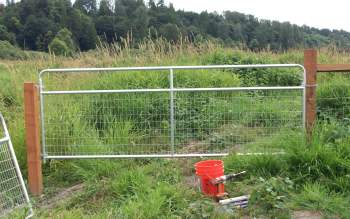
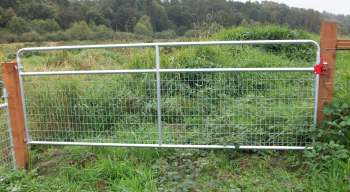




 To make sure you can have the top finial pointing downward, it’s important to place the top bolt high enough that you can have the hinge positioned lower on the gate that the bolt’s “finial” and then slide it up onto the “finial”. Err on the side of putting the bolt too high than too low. Once the hinge bracket is on the finial, you tighten the bolts down, and the weight of the gate is actually pulling mostly sideways against this “finial” (thus it doesn’t need to sit “down” on an upward-pointing “finial”- only the bottom hinge needs to do that). I had a couple of cases where I didn’t plan right, or had another object in the way, and ended up with the top “finial” pointing upwards. It turns out, it works OK as long as the gate is a big one– the weight of the gate still “binds” it plenty on the hinge bolt to where even a lot of force won’t slide it up and off the bolts. But, this would not be true for smaller gates.
To make sure you can have the top finial pointing downward, it’s important to place the top bolt high enough that you can have the hinge positioned lower on the gate that the bolt’s “finial” and then slide it up onto the “finial”. Err on the side of putting the bolt too high than too low. Once the hinge bracket is on the finial, you tighten the bolts down, and the weight of the gate is actually pulling mostly sideways against this “finial” (thus it doesn’t need to sit “down” on an upward-pointing “finial”- only the bottom hinge needs to do that). I had a couple of cases where I didn’t plan right, or had another object in the way, and ended up with the top “finial” pointing upwards. It turns out, it works OK as long as the gate is a big one– the weight of the gate still “binds” it plenty on the hinge bolt to where even a lot of force won’t slide it up and off the bolts. But, this would not be true for smaller gates.




